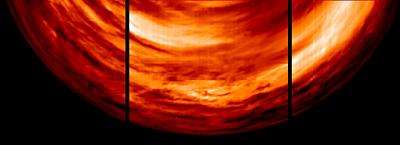Complex meteorology at Venus

In its relentless probing of Venus's atmosphere, ESA's Venus Express keeps revealing new details of the Venusian cloud system. Meteorology at Venus is a complex matter, scientists say.
New night-side infrared images gathered by the Ultraviolet, Visible and Near-Infrared Mapping Spectrometer (VIRTIS) in July 2006, clearly show new details of a complex cloud system. The first (false colour) view - the composite of three infrared images acquired by VIRTIS, was taken on 22 July when the spacecraft was flying around the apocentre of its orbit (point of maximum distance from the planet surface) at about 65 000 kilometres altitude. Venus was in the night side.
Using its capability to observe at 1.7-micrometre wavelenght, VIRTIS could probe at about 15-20 kilometres altitude, below the thick cloud deck situated at about 60 kilometres from the surface. The thermal radiation coming from the oven-hot surface of Venus is represented by the intensity of the colours: the brighter the colour (towards white), the more radiation comes from the surface, so the less cloudy the region in the line of sight between the view and the spacecraft is.
The edge of the images, taken at a time interval of about 30 minutes from each other, do not precisely match. This is due to the fact that clouds on Venus move very rapidly and constantly vary their shape. Venus's atmosphere is certainly the most dynamic among the terrestrial planets that have one, taking only four days to completely rotate around the planet.
"Clouds at Venus present repetitive patterns and recurrent features, but they are very variable in position both on short and long time scales," said Giuseppe Piccioni who, with Pierre Drossart, is the instrument co-Principal Investigator. "This makes meteorology a very complex matter for this planet."
Since the thermal radiation from the surface of Venus is in practice modulated by the presence of the clouds, taking the negative of the image it is possible to see directly the clouds structure on the night side, and so study its morphology and dynamics.
This was done for this other night-side image, acquired by VIRTIS on 29 July around apocentre from a distance of about 65 000 kilometres from the surface.
The 2.3-micrometre wavelength used for this image brought the 'view' again down below the cloud deck. The large cloud visible in the centre of the image and extending toward the bottom-right part is about 2000 kilometres long and 500 kilometres wide.
This cloud presents the familiar and peculiar shape of clouds at Venus. They are usually elongated due to the very high-speed winds – reaching up the formidable velocity of 360 kilometres per hour and being caused by the 'super-rotation' of the atmosphere.
The very cloudy region visible at the top-right of the image is situated beyond 60º South latitude, and represents the transition to the region where the atmosphere is dominated by the effects of the powerful South double polar vortex.
Source: European Space Agency



















